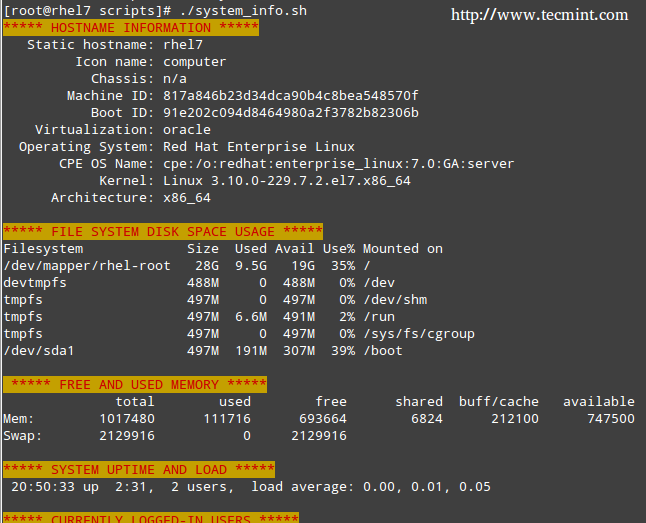echo -e “\e[1;32mDone.\e[0m”
然后,给脚本可执行权限,并运行脚本:
chmod +x system_info.sh
./system_info.sh
为了更好的可视化效果各部分标题都用颜色显示:

颜色功能是由以下命令提供的:
echo -e “\e[COLOR1;COLOR2m\e[0m”
其中 COLOR1 和 COLOR2 是前景色和背景色,是你想用颜色显示的字符串。
使任务自动化
你想使其自动化的任务可能因情况而不同。因此,我们不可能在一篇文章中覆盖所有可能的场景,但是我们会介绍使用 shell 脚本可以使其自动化的三种典型任务:
1) 更新本地文件数据库
1) 查找(或者删除)有 777 权限的文件
2) 文件系统使用超过定义的阀值时发出警告。
让我们在脚本目录中新建一个名为 auto\_tasks.sh 的文件并添加以下内容:
#!/bin/bash
自动化任务示例脚本:
-更新本地文件数据库:
echo -e “\e[4;32mUPDATING LOCAL FILE DATABASE\e[0m”
updatedb
if [ $? == 0 ]; then
echo “The local file database was updated correctly.”
else
echo “The local file database was not updated correctly.”
fi
echo “”
-查找 和/或 删除有 777 权限的文件。
echo -e “\e[4;32mLOOKING FOR FILES WITH 777 PERMISSIONS\e[0m”
Enable either option (comment out the other line), but not both.
Option 1: Delete files without prompting for confirmation. Assumes GNU version of find.
#find -type f -perm 0777 -delete
Option 2: Ask for confirmation before deleting files. More portable across systems.
find -type f -perm 0777 -exec rm -i {} +;
echo “”
-文件系统使用率超过定义的阀值时发出警告
echo -e “\e[4;32mCHECKING FILE SYSTEM USAGE\e[0m”
THRESHOLD=30
while read line; do
# This variable stores the file system path as a string
FILESYSTEM=$(echo $line | awk '{print KaTeX parse error: Expected 'EOF', got '}' at position 2: 1}̲') # Th…(echo $line | awk '{print KaTeX parse error: Expected 'EOF', got '}' at position 2: 5}̲') # Us…{PERCENTAGE%?}
if [ $USAGE -gt $THRESHOLD ]; then
echo “The remaining available space in $FILESYSTEM is critically low. Used: $PERCENTAGE”
fi
done < <(df -h --total | grep -vi filesystem)
请注意该脚本最后一行两个 < 符号之间有个空格。

使用 Cron
想更进一步提高效率,你不会只是想坐在你的电脑前手动执行这些脚本。相反,你会使用 cron 来调度这些任务周期性地执行,并把结果通过邮件发送给预先指定的接收者,或者将它们保存到使用 web 浏览器可以查看的文件中。
下面的脚本(filesystem\_usage.sh)会运行有名的 df -h 命令,格式化输出到 HTML 表格并保存到 report.html 文件中:
#!/bin/bash
演示使用 shell 脚本创建 HTML 报告的示例脚本
Web directory
WEB_DIR=/var/www/html
A little CSS and table layout to make the report look a little nicer
echo "
" > $WEB_DIR/report.html # View hostname and insert it at the top of the html body HOST=$(hostname) echo "Filesystem usage for host $HOSTLast updated: $(date)
" >> $WEB_DIR/report.html # Read the output of df -h line by line while read line; do echo "" >> $WEB_DIR/report.html done < <(df -h | grep -vi filesystem) echo "
| Filesystem | Size | Use % |
|---|---|---|
| " >> $WEB_DIR/report.html echo $line | awk '{print $1}' >> $WEB_DIR/report.html echo " | " >> $WEB_DIR/report.html echo $line | awk '{print $2}' >> $WEB_DIR/report.html echo " | " >> $WEB_DIR/report.html echo $line | awk '{print $5}' >> $WEB_DIR/report.html echo " |
在我们的 RHEL 7 服务器(192.168.0.18)中,看起来像下面这样:




67)]
[外链图片转存中…(img-l1oRsAYd-1725964366768)]
[外链图片转存中…(img-FoH3vJc3-1725964366768)]
[外链图片转存中…(img-tOeYZJS3-1725964366769)]
既有适合小白学习的零基础资料,也有适合3年以上经验的小伙伴深入学习提升的进阶课程,涵盖了95%以上运维知识点,真正体系化!





















 被折叠的 条评论
为什么被折叠?
被折叠的 条评论
为什么被折叠?








